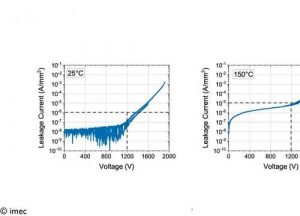Epitaxial growth of GaN buffer layers demo-ed at Imec

The manufacturability of 1200V-qualified buffer layers opens doors to highest voltage GaN-based power applications such as electric cars, previously only with feasible silicon-carbide (SiC)-based technology.
The result comes after the successful qualification of AIXTRON’s G5+ C fully automated metal-organic chemical vapor deposition (MOCVD) reactor at imec, Belgium, for integrating the optimized material epi-stack.
Wide-bandgap materials gallium-nitride (GaN) and silicon-carbide (SiC) have proved their value as next-generation semiconductors for power-demanding applications where silicon (Si) falls short. SiC-based technology is the most mature, but it is also more expensive.
Over the years tremendous progress has been made with GaN-based technology grown on for example 200mm Si wafers. At imec, qualified enhancement mode high-electron-mobility transistors (HEMTs) and Schottky diode power devices have been demonstrated for 100V, 200V and 650V operating voltage ranges, paving the way for high-volume manufacturing applications.
However, achieving operating voltages higher than 650V has been challenged by the difficulty of growing thick-enough GaN buffer layers on 200mm wafers. Therefore, SiC so far remains the Semiconductor of choice for 650-1200V applications – including for example electric cars and renewable energy.
For the first time, imec and AIXTRON have demonstrated epitaxial growth of GaN buffer layers qualified for 1200V applications on 200mm QST (in SEMI standard thickness) substrates at 25°C and 150°C, with a hard breakdown exceeding 1800V.
Denis Marcon, Senior Business Development Manager at Imec stated: “GaN can now become the technology of choice for a whole range of operating voltages from 20V to 1200V. Being processable on larger wafers in high-throughput CMOS fabs, power technology based on GaN offers a significant cost advantage compared to the intrinsically expensive SiC-based technology.”
Key to achieving the high breakdown voltage is the careful engineering of the complex epitaxial material stack in combination with the use of 200mm QST substrates, executed in scope of the IIAP program The CMOS-fab friendly QST substrates from Qromis have a thermal expansion that closely matches the thermal expansion of the GaN/AlGaN epitaxial layers, paving the way for thicker buffer layers – and hence higher voltage operation.
D